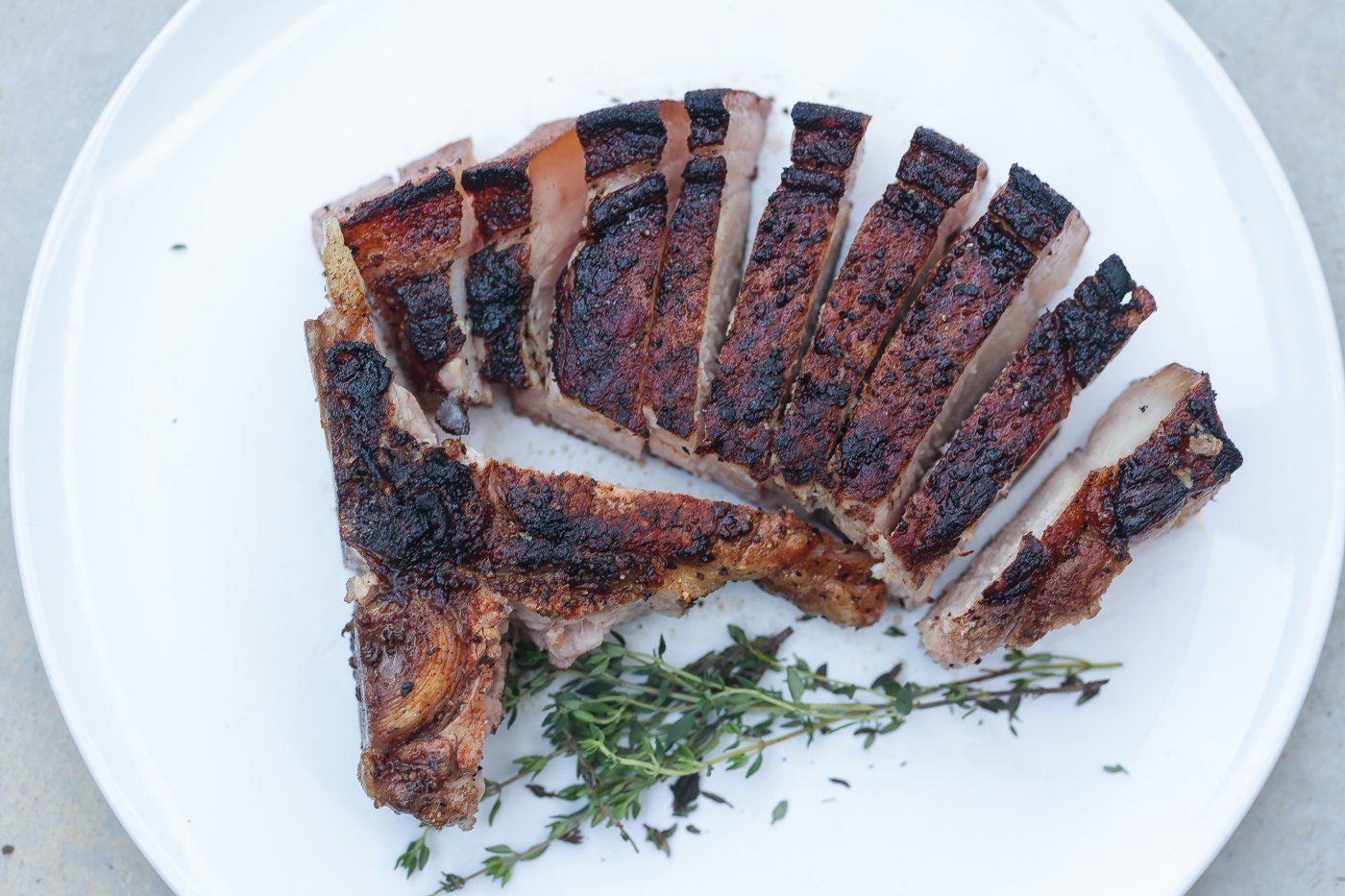Related Posts:
- Tomahawk Pork Chops
- Smoked Pork Chops
- Chicago Style Rib Tips
You ever had chewy overcooked pork chops that taste like wood and wondered if there was a fail-safe way to cook juicy delicious pork chops every time? Well worry no longer because these reverse seared pork chops are your solution.
Ah, gather 'round for I'm about to take you on a tantalizing journey through the art of reverse searing pork chops, a melody of flavor that'll set your taste buds on fire. Picture a sizzling symphony in a cast-iron orchestra, where pork chops take center stage, dancing gracefully in fiery heat.
With well-seasoned notes, and as we step in the name of love through this soulful recipe, we'll create a most delicious pan sauce, actin like a soulful chorus that'll harmonize with those juicy porky melodies, elevatin' the culinary blues to a level of pure, savory delight. So, kick off your shoes, let the records spin, and let's cook up some old-fashioned, soul-stirrin magic.
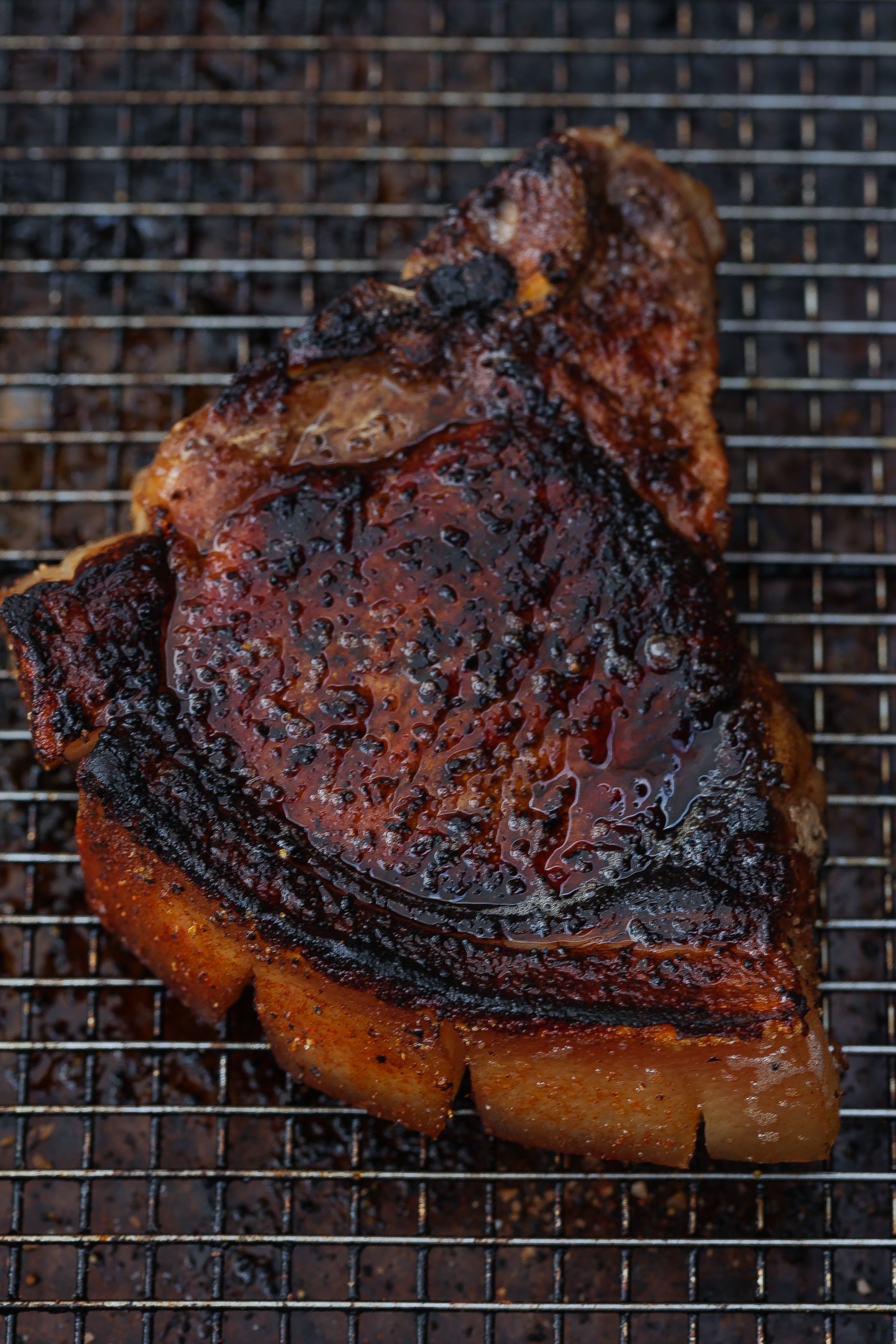
My Motivation
I usually cook thick pork chops using the sous vide method to get the perfect internal temperature every time. However, it requires time and planning. I was looking for a way to get similar results in less time. Figured if reverse searing worked for steaks then it would work for pork chops.
Beats and Eats (music to pair with these pork chops)
Pairing Willie Hutch's song "The Way We Were" with a reverse-seared pork chop accompanied by an apple cider-based pan sauce creates a harmonious and nostalgic culinary experience.
The smooth and soulful melody of the song complements the slow and deliberate cooking method of reverse-searing the pork chops, enhancing the overall enjoyment of the meal.
The sweet and tangy notes of the apple cider-based pan sauce echo the emotions conveyed in the song, adding a delightful and comforting element to the dining experience, reminiscent of cherished memories from the past.
What Is the Reverse Searing Method
The reverse searing method, is like a vintage technique in the grand symphony of cooking, sort of like a soulful ballad played in reverse. Picture this: instead of the conventional route, where we sear the meat first, we begin with a slow and gentle serenade of heat baking at a low temperature.
The meat, often a delectable cut like a ribeye or thick pork chop, is tenderly caressed by a low, indirect temperature, allowing the natural flavors to harmonize and deepen. This slow dance tenderizes the interior, akin to an old record playing softly in the background.
Once the core has found its tempo, we cast the spotlight upon the meat, searing it over high heat, bringing forth a rich, caramelized crust – the crescendo of our symphony if you will. The result? A tender, succulent interior enveloped by a luscious, flavorful exterior, a culinary duet that'll leave your palate singing with pure joy.
What Is Eating This Pork Chop Recipe Like
Indulging in pan-seared pork chops graced by a drizzle of apple cider-based pan sauce is a wonderful thing. As you savor each succulent bite, the flavors dance on your tongue in a smooth two step, orchestrated by the tender, seared crust that yields to a melody of juiciness within.
The apple cider-infused pan sauce, a maestro of the ensemble, adds a harmonious note of tartness and subtle sweetness, enhancing the pork's natural soulful essence. It's as if autumn leaves are swirling around, bringing a hint of crispness to the air, while the marriage of pork and sauce takes your taste buds on a culinary voyage through a landscape of comforting, soul-soothing blissfulness.
The texture of a pan-seared pork chop is a tale of contrasts, a melodic dance between the tender and the crisp. As you delve into this tender chop, your teeth first meet the outer crust, a delicate yet robust layer, achieved by the high-heat searing process. This outer layer orchestrates a delightful crunch, resonating like a drum beat in the mouth.
Beyond the crust lies the heart of the matter—the pork's interior—a tender, yielding performance that's both tender and juicy. The slow serenade of the reverse-searing technique ensures the meat retains its moisture and tenderness, allowing for a harmonious contrast with the crust. It's a duet of textures, each note playing off the other, offering a truly delightful dining experience that engages the senses in a gastronomic ballet.
Why My Version Is Different
Reverse searing is a popular technique for cooking steaks. You don't hear as much talk about it with pork. I figured if it worked with steaks, then why wouldn't it work with thick-cut pork chops. This is a great recipe but what really separates it is the apple cider-based pan sauce. It's sweet, savory, buttery, and a perfect compliment to the seared pork.
What Key Ingredients Are Needed To Make These Reverse Seared Pork Chops
For the Pork Chops
- Bone-in Pork Chop (Thick Cut)
- Paprika - also known as pimentón, is a spice renowned for its distinctive and robust flavor profile. Imagine a deep, smoky essence intermingling with a gentle sweetness and mild bitterness, akin to a well-rounded ensemble of flavors.
- Kosher Salt
- Black Pepper
- Ground Allspice - has a warm and slightly spicy taste, reminiscent of a blend of cinnamon, cloves, and nutmeg. This combination brings a comforting warmth to dishes.
For the Brine
- Water
- Brown Sugar - brings a noticeable sweetness to the brine. This sweetness is not as intense as white sugar and carries a hint of molasses, providing a deeper, more complex sweetness to balance the savory and salty elements in the brine.
- Salt
- Black Peppercorns
- Allspice Berries - carry a mild peppery note, subtly contributing to the overall spiciness of the brine. It's not overpowering but adds a gentle kick that enhances the complexity of the taste.
- Fresh Thyme - has a mild minty quality that can provide a refreshing and uplifting note to the brine, adding a touch of brightness.
For the Pan Sauce
- Butter - contributes a rich, creamy, and slightly nutty flavor to the sauce, enhancing the overall taste and making it more appealing.
- Garlic Cloves - is aromatic and provides a strong, enticing aroma that can elevate the sensory experience of the dish.
- Apple Cider Vinegar - contributes a tart/tangy flavor to the sauce, balancing and brightening the overall taste profile. The acidity helps cut through the richness, preventing the sauce from being overly heavy. It's also used for deglazing the pan, helping to lift and incorporate the flavorful browned bits from the pan into the sauce, intensifying the sauce's taste.
- Dijon Mustard - contributes a distinctive, tangy, and slightly spicy flavor to the sauce, enriching the overall taste profile and adding depth. Also acts as an emulsifier, helping to combine and stabilize the ingredients in the sauce, resulting in a smoother and cohesive mixture.
How To Make Perfectly Cooked Pork Chops Step by Step
Brine the Chops
Place all the brine ingredients in a large mixing bowl and mix until sugar and salt fully dissolve. Place the pork chops in a large sealable ziplock bag or container with a lid. Add the brine and refrigerate overnight.
Cook the Chops
Remove the chops from the refrigerator, remove from the brine and allow to reach room temperature. Pat chops dry with a paper towel. Season the pork chops liberally with seasoning mix.
Place the seasoned pork chops on a wire rack-lined baking sheet. Bake at 250 degrees F for 30 minutes. Remove pork chops from the oven and prepare to sear them in cast iron skillet.
Heat skillet on high heat. Add a high smoke point oil like avocado oil or ghee (clarified butter).
Sear the chops for 1-2 minutes (depending on thickness) per side in a cast iron pan. Sear the fat cap for 30 seconds holding the chops upright with a set of tongs.
Level up by adding butter, garlic clove, and thyme to the pan during searing. Baste the pork chops with the butter constantly.
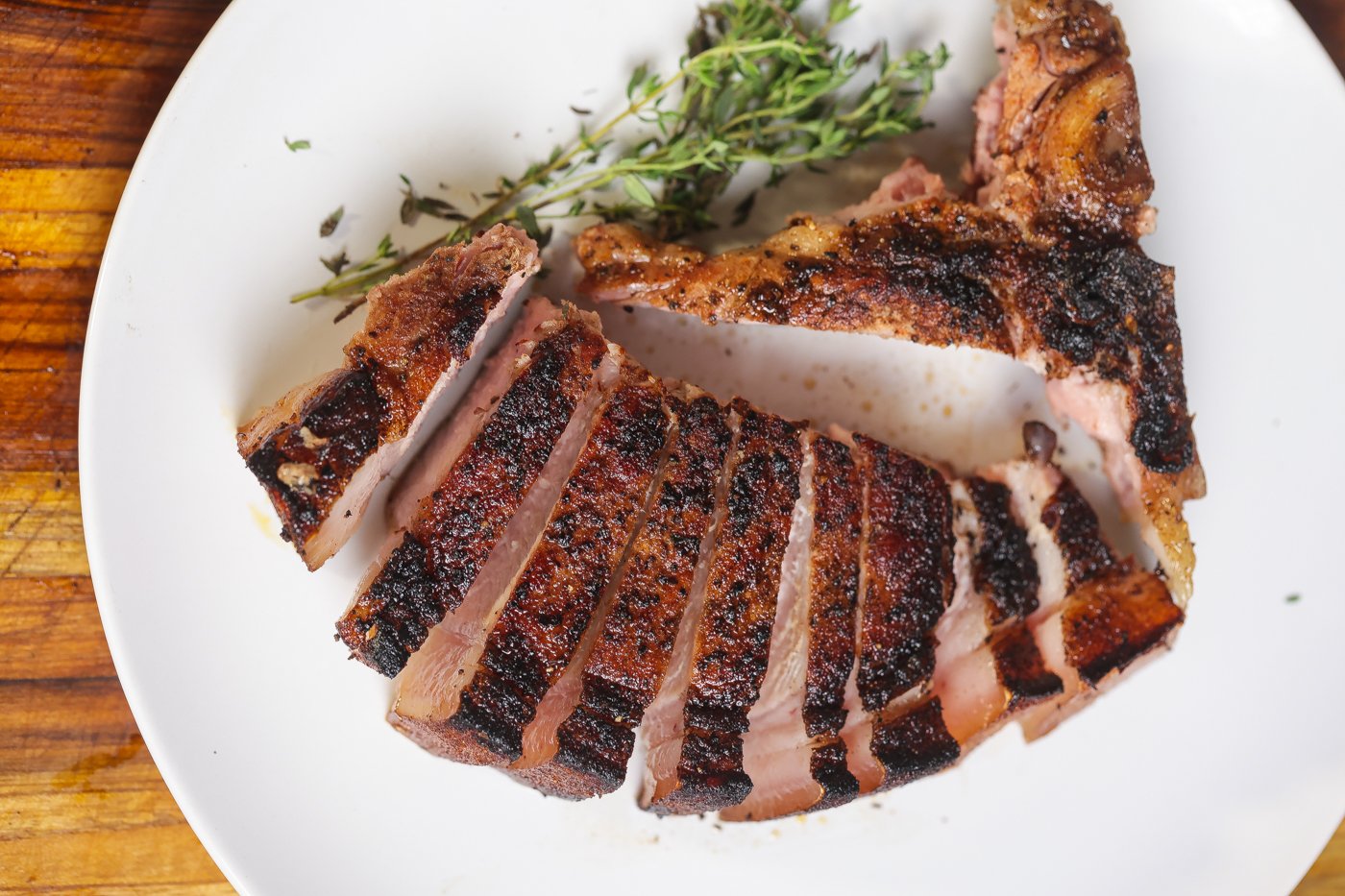
Elevating the Experience: Crafting a Flavorful Pan Sauce
Remove the pork chops from the pan and allow to rest while you make the sauce. Add the chicken stock and allow to cook on medium high heat for 2-3 minutes.
Add the cider vinegar, mix in well, and deglaze the pan by scraping up all the brown bits. Add the thyme, sage, and mustard. Stir well then reduce to thicker consistency.
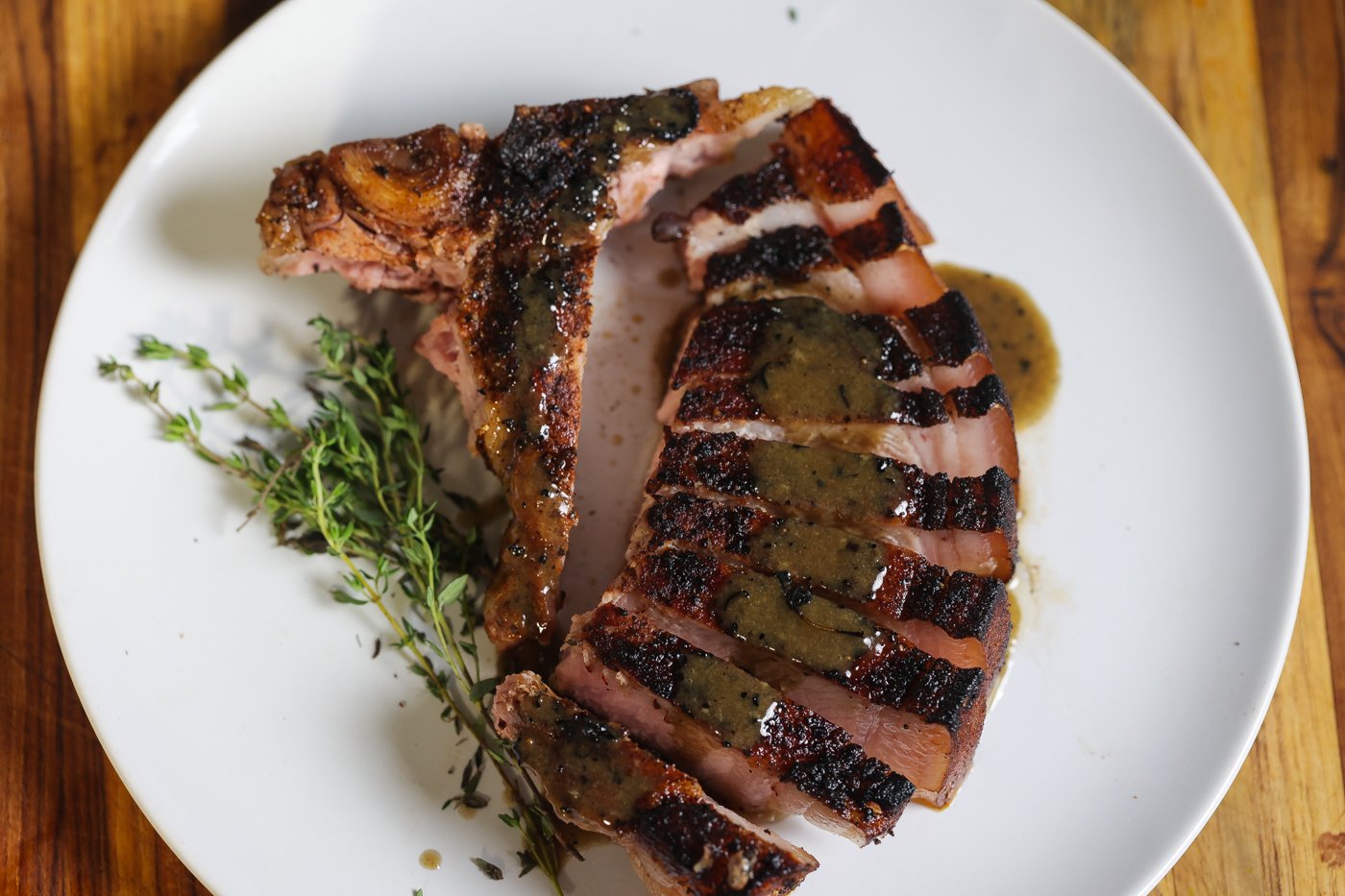
What Are The Best Sides To Serve with Pork Chops
Pairing the right sides with pork chops can elevate the overall dining experience by providing complementary flavors, textures, and visual appeal. Here are some popular and delicious side dishes to serve with pork chops:
- Mashed Potatoes: Creamy mashed potatoes are a classic and comforting choice that pairs well with the savory flavors of pork chops.
- Roasted Vegetables: Roasted vegetables like carrots, Brussels sprouts, asparagus, or sweet potatoes add a flavorful and colorful element to the plate.
- Grilled Vegetables: Grilled vegetables, seasoned with herbs and olive oil, provide a smoky and slightly charred flavor that complements pork chops.
- Baked Beans: Baked beans offer a hearty and flavorful side that pairs well with the richness of pork chops.
- Coleslaw: A zesty and crunchy coleslaw can provide a refreshing contrast to the savory pork chops.
- Corn on the Cob: Grilled or boiled corn on the cob is a classic and delicious side that pairs well with pork chops.
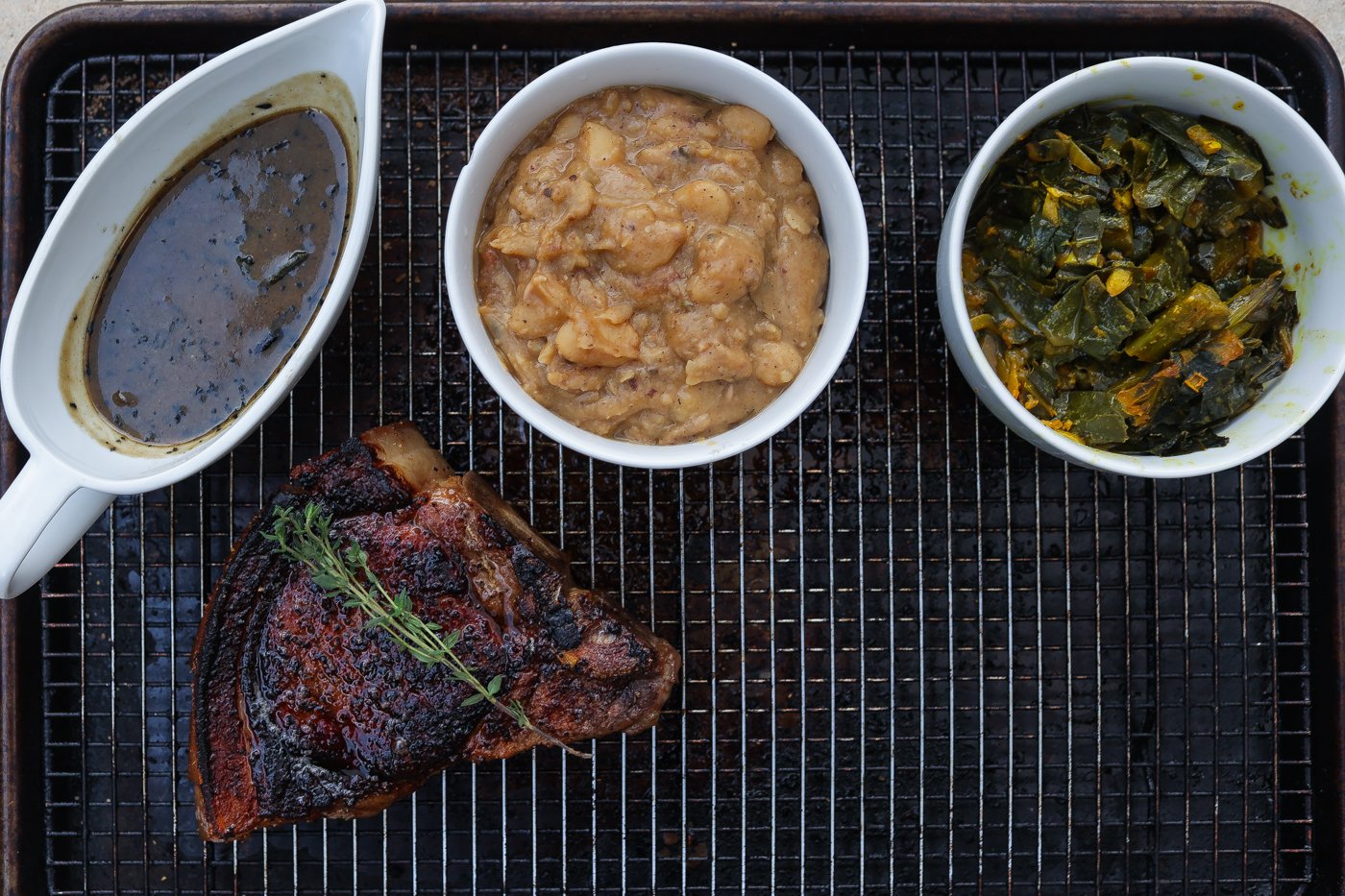
Tips for Maximizing Flavor
Maximizing the flavor of pork chops involves various cooking techniques, seasoning choices, and considerations during the cooking process. Here are some tips to help you achieve delicious and flavorful pork chops:
- Choose Quality Pork: Opt for high-quality, well-marbled pork chops. The marbling contributes to juiciness and enhances the flavor during cooking.
- Brining: Consider brining the pork chops before cooking. Brining involves soaking the pork in a mixture of water, salt, sugar, and sometimes spices, enhancing flavor and moisture retention.
- Season Well: Season the pork chops generously with a blend of spices, herbs, salt, and pepper. Common choices include garlic, thyme, rosemary, paprika, or a pre-made pork seasoning mix.
- Allow Time to Rest: Allow the seasoned or marinated pork chops to rest at room temperature for about 30 minutes before cooking. This helps them cook more evenly and enhances flavor.
- Sear for Flavor: Sear the pork chops in a hot skillet or pan with a bit of oil to develop a flavorful crust on the outside. Searing locks in juices and adds a caramelized flavor.
- Use Herbs and Aromatics: Cook the pork chops with fresh herbs (e.g., thyme, rosemary) and aromatics (e.g., garlic, shallots) to infuse additional flavors.
- Rest Before Serving: Allow the cooked pork chops to rest for a few minutes before serving. This helps redistribute the juices within the meat, ensuring a juicy and flavorful bite.
- Pair with Complementary Flavors: Serve the pork chops with complementary flavors like apple sauce, caramelized onions, or a fruit chutney to enhance the taste
How To Choose The Best Pork Chop For Reverse Searing
Choosing the best pork chop for reverse searing involves considering factors such as thickness, cut, marbling, and bone-in versus boneless options. Here are steps to help you choose the perfect pork chop for a successful reverse sear:
- Select a Thick Cut: Choose pork chops that are thick (at least 1 to 1.5 inches thick). Thicker cuts allow for a more gradual cooking process during the reverse sear, resulting in a tender and juicy interior. Go with thick pork chops with much marbling/fat. Thicker the cut, the harder to overcook.
- Choose the Right Cut: Common cuts for pork chops suitable for reverse searing include rib chops, center-cut chops, and loin chops. These cuts have a good balance of meat and fat.
- Look for Marbling: Opt for pork chops with visible marbling (intramuscular fat). Marbling enhances flavor, tenderness, and juiciness during the cooking process.
- Fresh and High-Quality Meat: Choose fresh, high-quality pork from a trusted source. Look for meat that has a pinkish-red color and is free from any off odors or signs of spoilage.
- Inspect for Uniformity: Look for uniformity in the shape of the chop. This will ensure even cooking and a consistent outcome.
Frequently Asked Questions About Reverse Searing Pork Chops
Can You Reverse Sear Pork Chops On The Grill?
Yes you can smoke pork chops using the reverse sear method. Try this grilled tomahawk pork chop recipe to see how. It's not difficult to do, but you will need a grill where you can move the temperature up or down for slow and low cooking and then direct high heat searing
What thickness of pork chops is best for reverse searing?
Thick-cut pork chops, typically around 1 to 1.5 inches thick, are ideal for reverse searing. The thickness allows for a gradual and controlled cooking process.
What Internal Temperature Should I Cook The Pork Chops?
The recommended internal cooking temperature for pork is 145°F (63°C). This temperature ensures that the pork is safe to eat while still retaining its juiciness and flavor. It's important to use a food thermometer to accurately measure the internal temperature of the pork to ensure it reaches this safe level.
Make This Pork Chop Recipe
If you make this pork chop recipe or any other from the site, please come back and leave me a comment below with your feedback. Definitely take a photo of the dish and be sure to tag #foodfidelity so that I can see them.
You can also keep up with my food exploits as well as original recipes! You can find me on Instagram, Facebook, Twitter, and Pinterest. If you like any of the music you find on the site, visit me at Spotify to find curated monthly playlists.
Lastly, go to my YouTube channel and subscribe to be notified when new weekly videos are uploaded.
Ingredients
For the Pork Chops
- 2 10 oz Bone-in Pork Chops
- 1 ½ teaspoons Paprika
- 1 teaspoon Kosher Salt
- 1 teaspoon Black Pepper
- ½ teaspoon Ground Allspice
- 1 tablespoon butter
- 1 clove garlic
For the Brine
- 4 cups Water
- 1 ½ cups Brown Sugar
- 2 tablespoons Kosher Salt
- 6 whole Black Peppercorns
- 6 whole Allspice Berries
- 3 sprigs Fresh Thyme
For the Pan Sauce
- 1 ½ cups Chicken Stock
- ¼ cup Apple Cider Vinegar
- ½ cup Dijon Mustard
- 1 sprig Fresh Thyme
- 1 leaf Fresh Sage
Instructions
Brine the Chops
- Place all the brine ingredients in a large mixing bowl and mix until sugar and salt fully dissolve. Place the pork chops in a large sealable ziplock bag or container with a lid. Add the brine and refrigerate overnight.
Cook the Chops
- Remove the chops from the refrigerator, remove from the brine and allow to reach room temperature. Pat chops dry with a paper towel. Mix all the spices together in a small bowl or ramekin. Season the pork chops liberally with seasoning mix.
- Place the seasoned pork chops on a wire rack-lined baking sheet. Bake at 250 degrees F for 30 minutes. Remove pork chops from the oven and prepare to sear them in cast iron skillet.
- Heat skillet on high heat. Add a high smoke point oil like avocado oil or ghee (clarified butter).
- Sear the chops for 1-2 minutes (depending on thickness) per side in a cast iron pan. Sear the fat cap for 30 seconds holding the chops upright with a set of tongs.
- Level up by adding butter and garlic clove to the pan during searing. Baste the pork chops with the butter
Make The Sauce
- Remove the pork chops from the pan and allow to rest while you make the sauce. Add the chicken stock and allow to cook on medium high heat for 2-3 minutes.
- Add the cider vinegar, mix in well, and deglaze the pan by scraping up all the brown bits. Add the thyme, sage, and mustard. Stir well then reduce to thicker consistency.
Notes
-
Tips for Maximizing Flavor
- Choose Quality Pork: Opt for high-quality, well-marbled pork chops. The marbling contributes to juiciness and enhances the flavor during cooking.
-
- Brining: Consider brining the pork chops before cooking. Brining involves soaking the pork in a mixture of water, salt, sugar, and sometimes spices, enhancing flavor and moisture retention.
-
- Season Well: Season the pork chops generously with a blend of spices, herbs, salt, and pepper. Common choices include garlic, thyme, rosemary, paprika, or a pre-made pork seasoning mix.
-
- Allow Time to Rest: Allow the seasoned or marinated pork chops to rest at room temperature for about 30 minutes before cooking. This helps them cook more evenly and enhances flavor.
-
- Sear for Flavor: Sear the pork chops in a hot skillet or pan with a bit of oil to develop a flavorful crust on the outside. Searing locks in juices and adds a caramelized flavor.
-
- Use Herbs and Aromatics: Cook the pork chops with fresh herbs (e.g., thyme, rosemary) and aromatics (e.g., garlic, shallots) to infuse additional flavors.
-
- Rest Before Serving: Allow the cooked pork chops to rest for a few minutes before serving. This helps redistribute the juices within the meat, ensuring a juicy and flavorful bite.
-
- Pair with Complementary Flavors: Serve the pork chops with complementary flavors like apple sauce, caramelized onions, or a fruit chutney to enhance the taste

